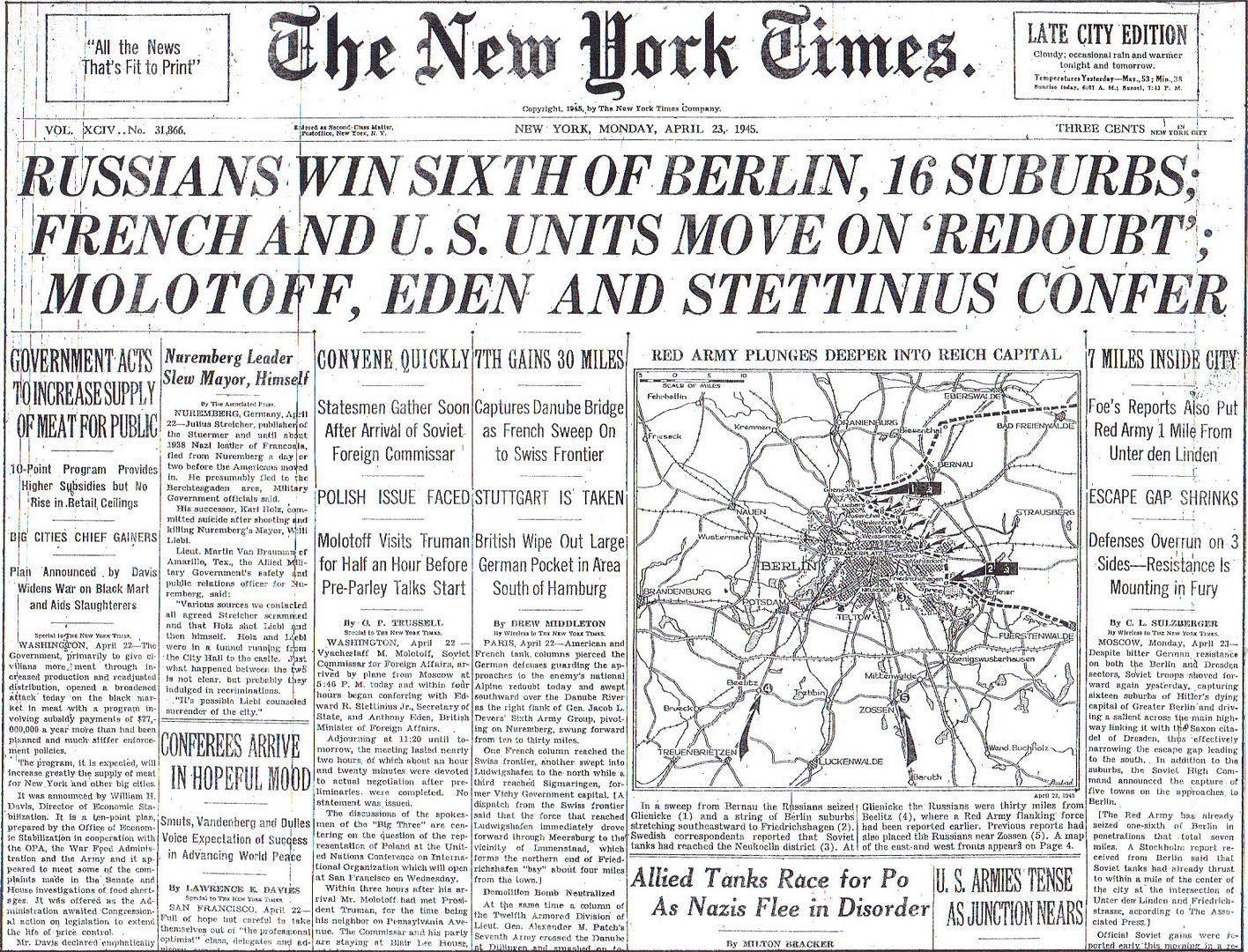
Posted on 04/23/2015 4:30:09 AM PDT by Homer_J_Simpson

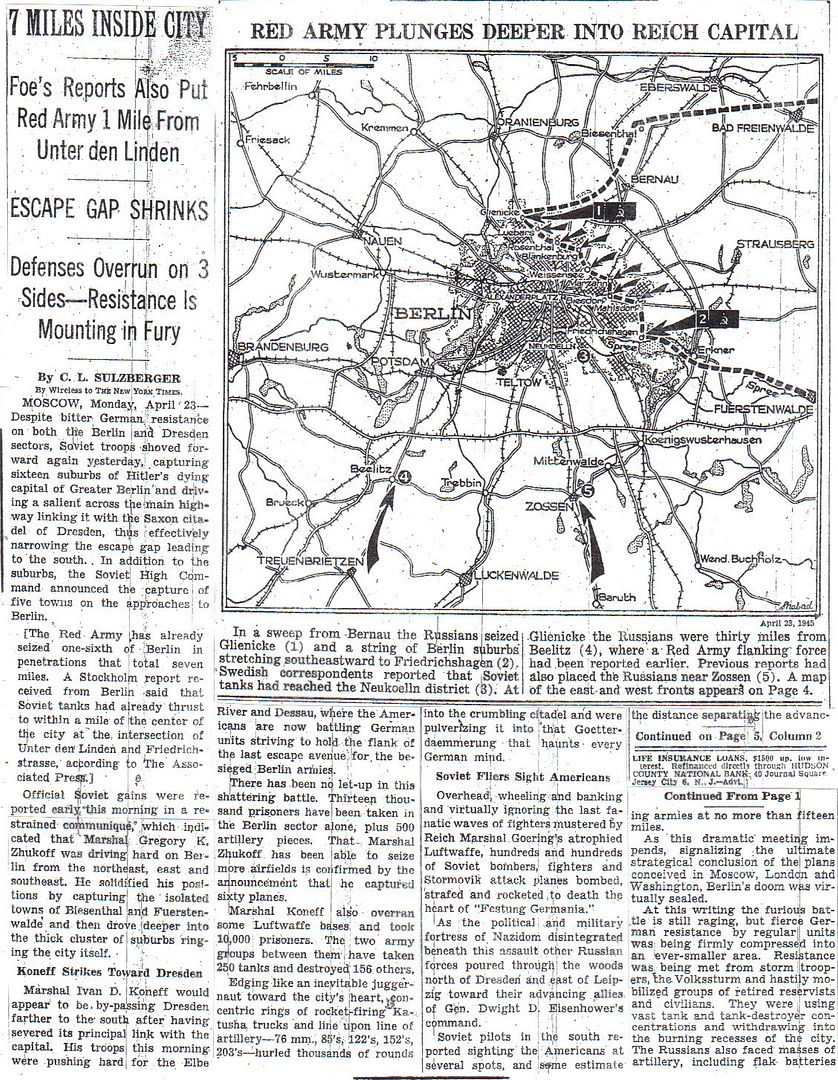
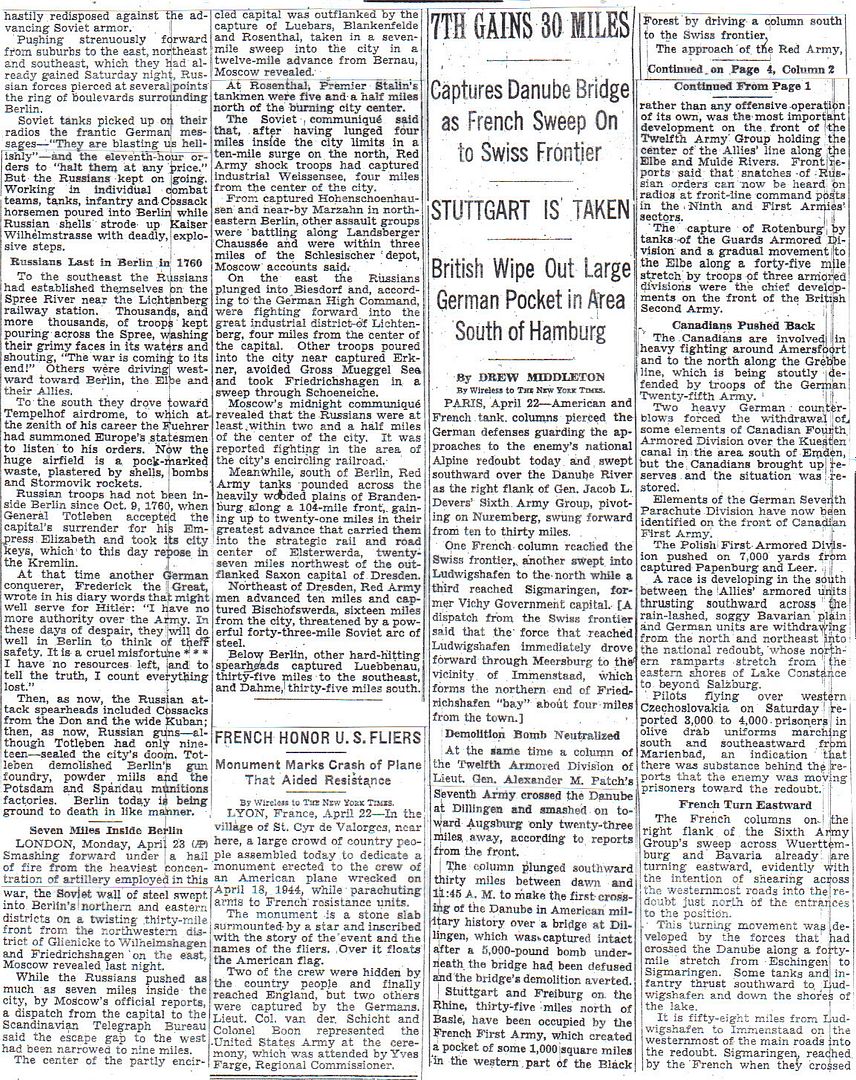
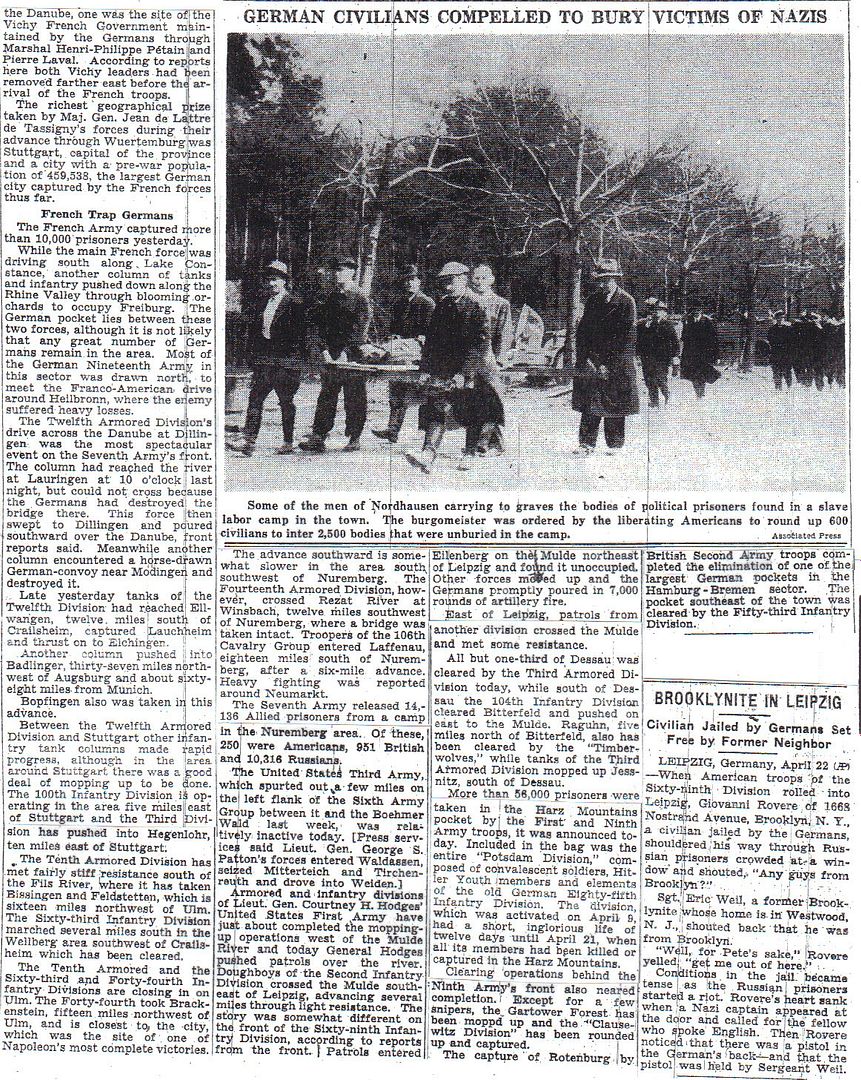
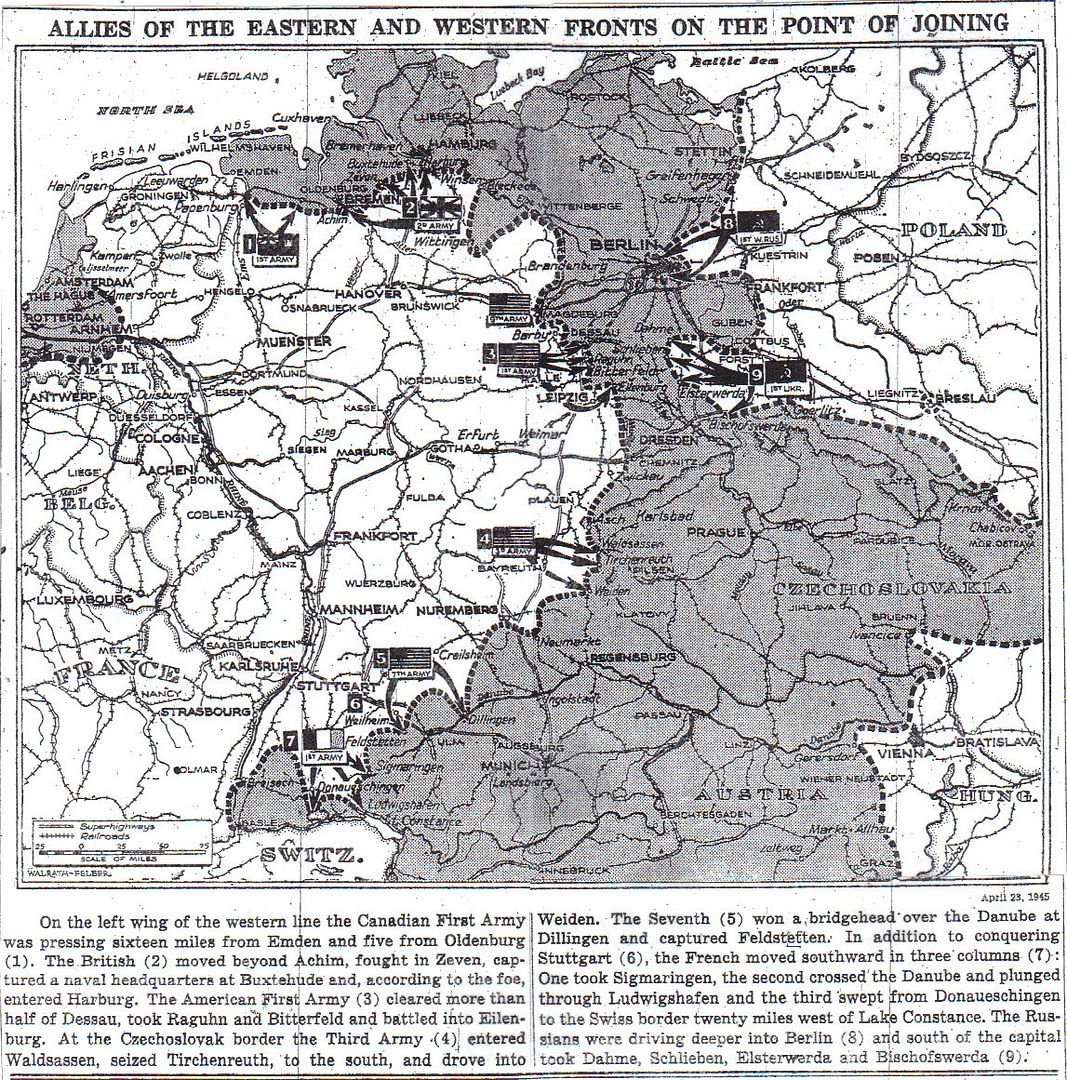
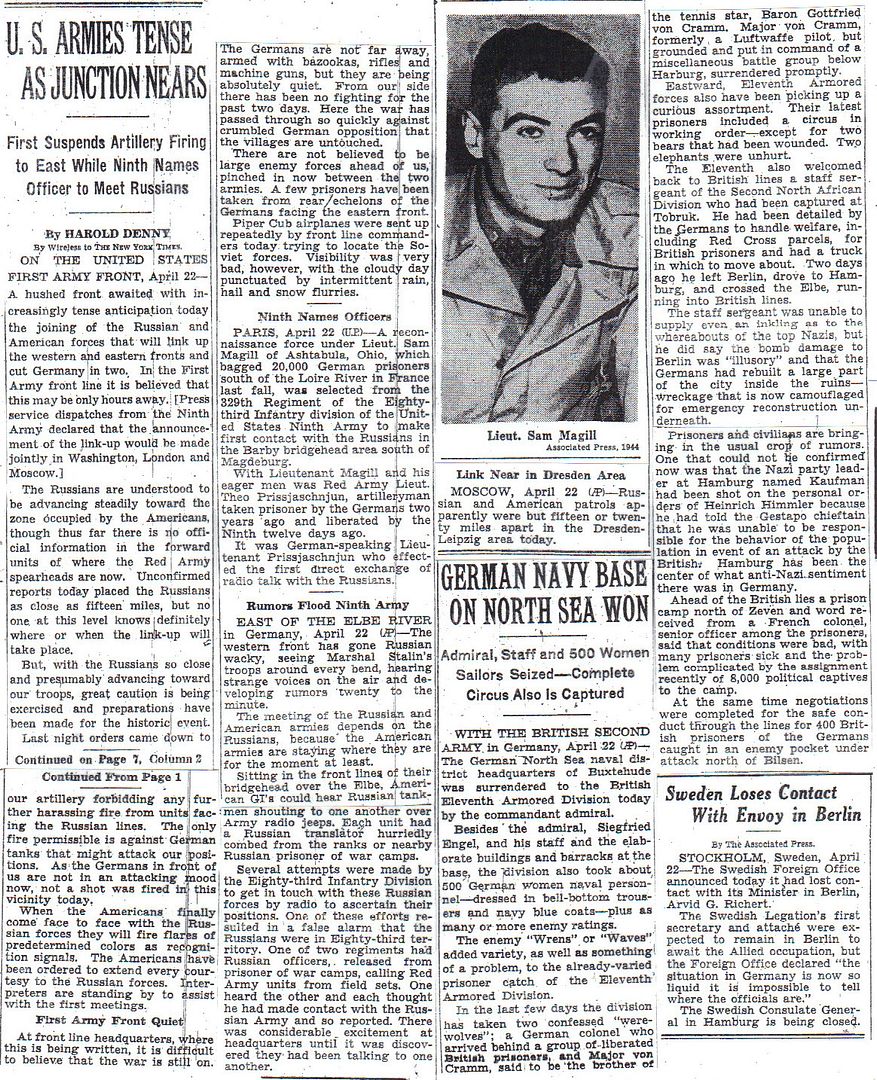
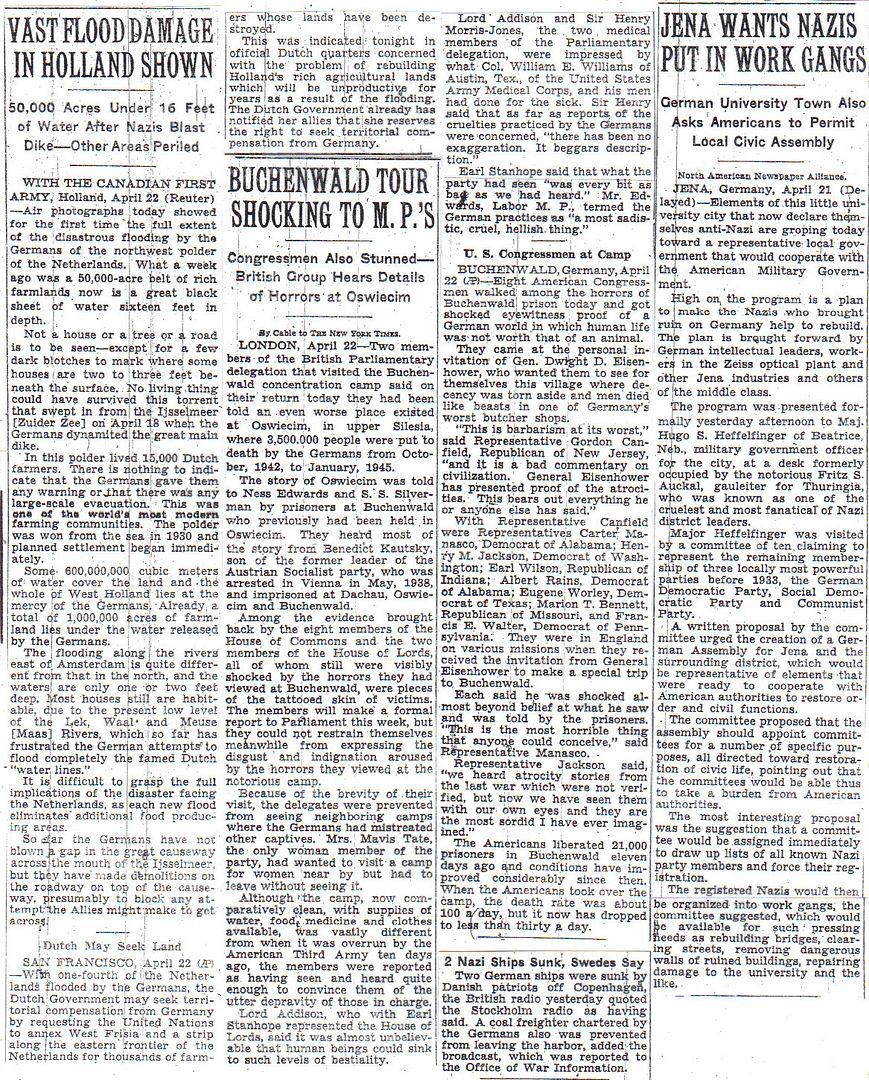
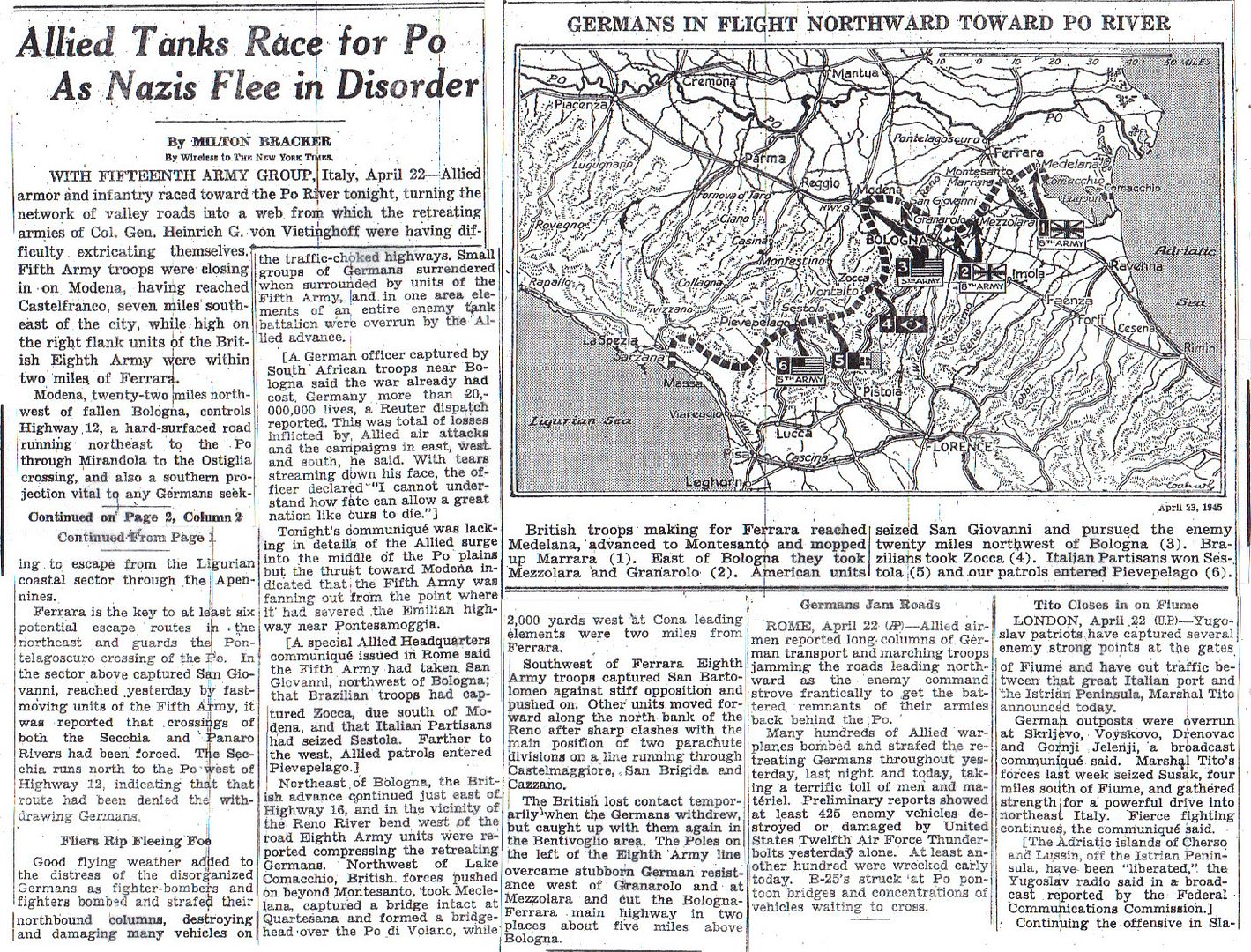
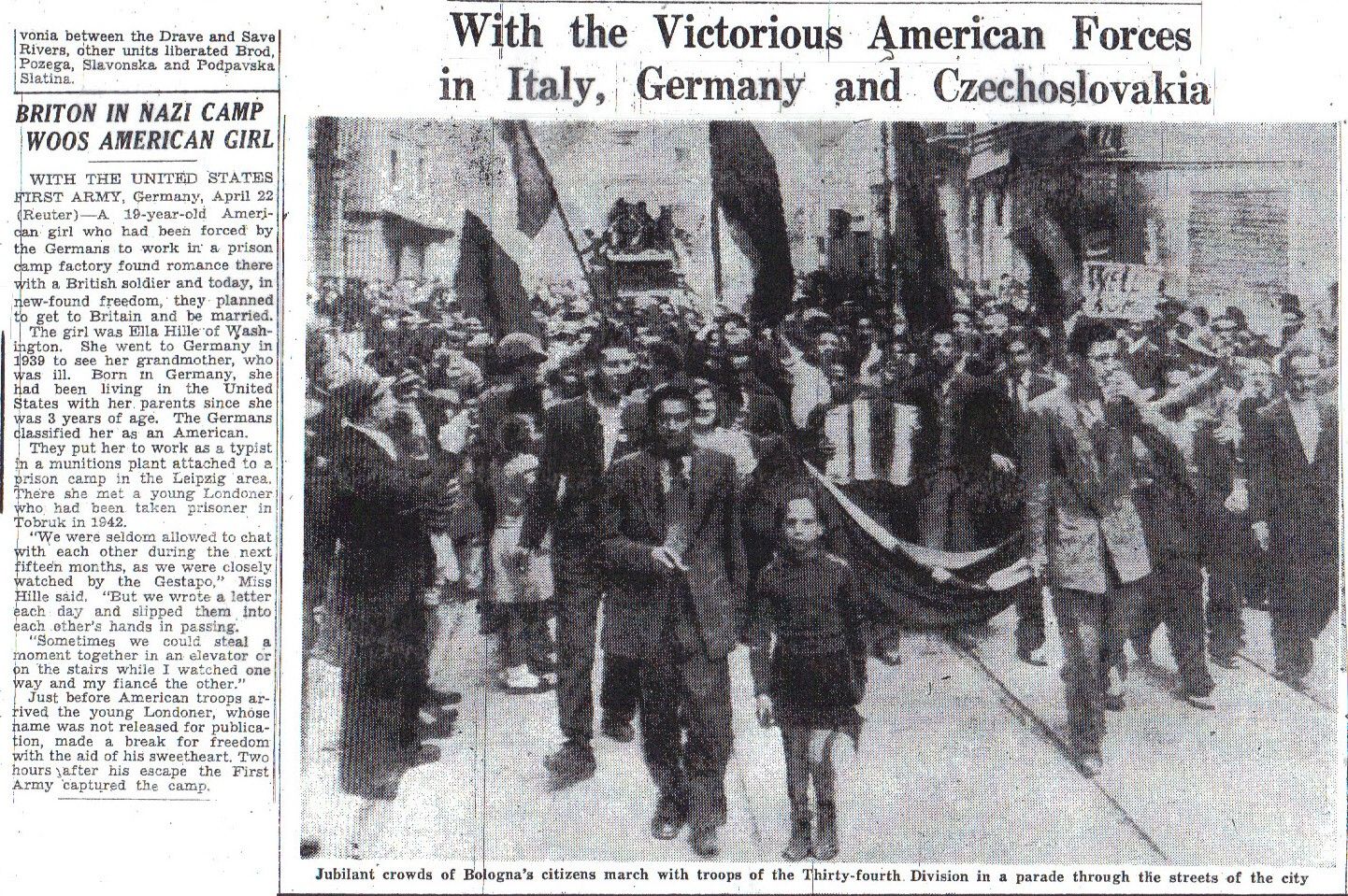
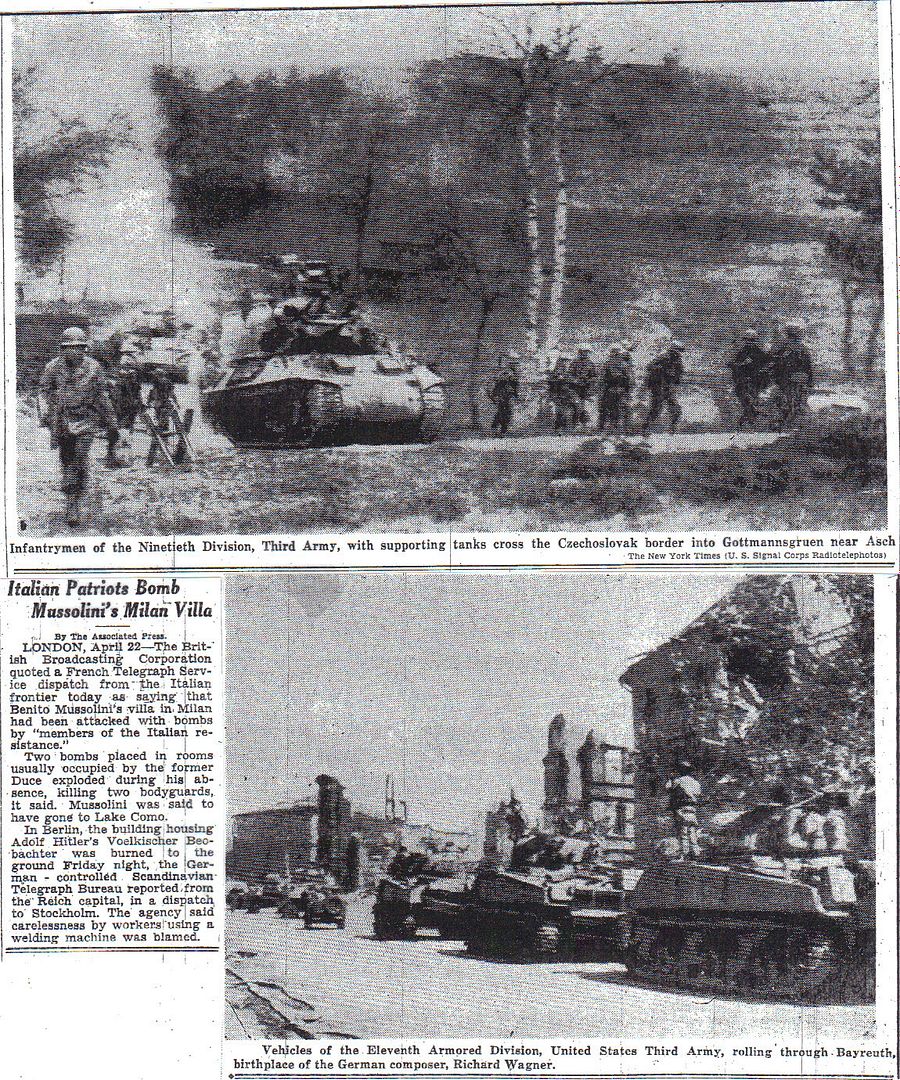

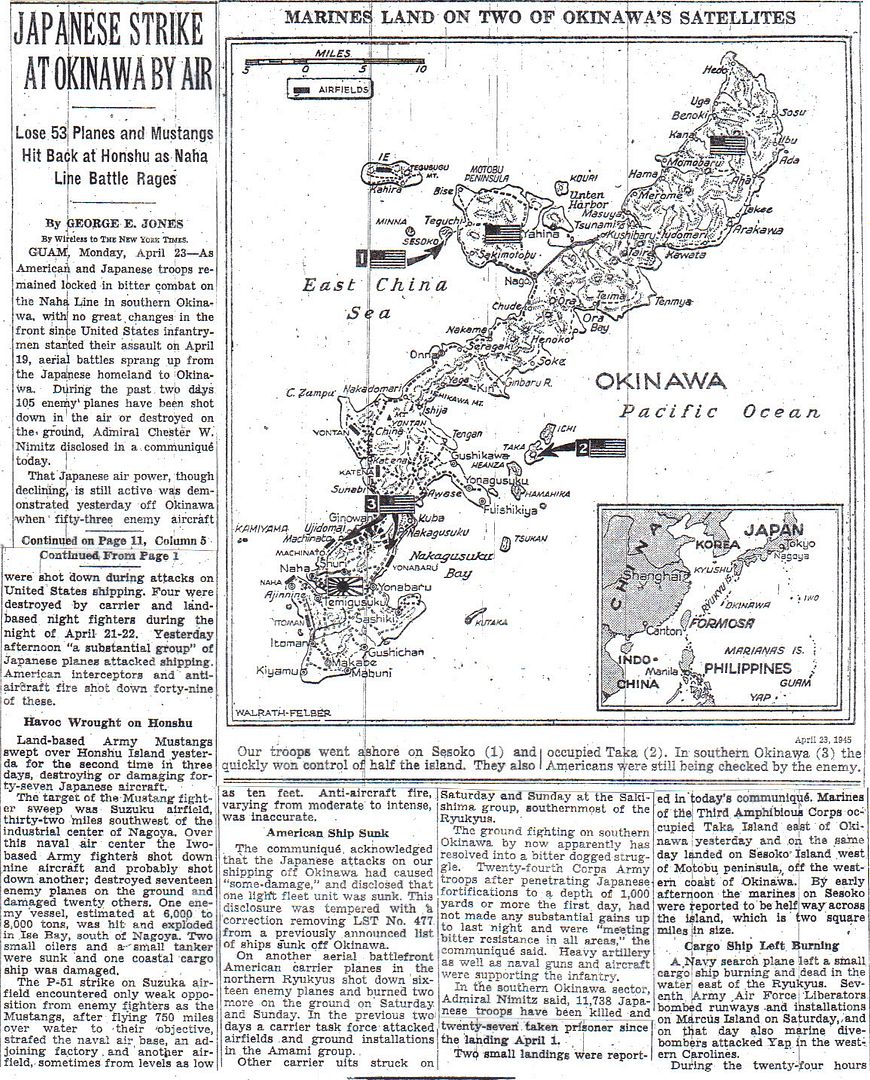
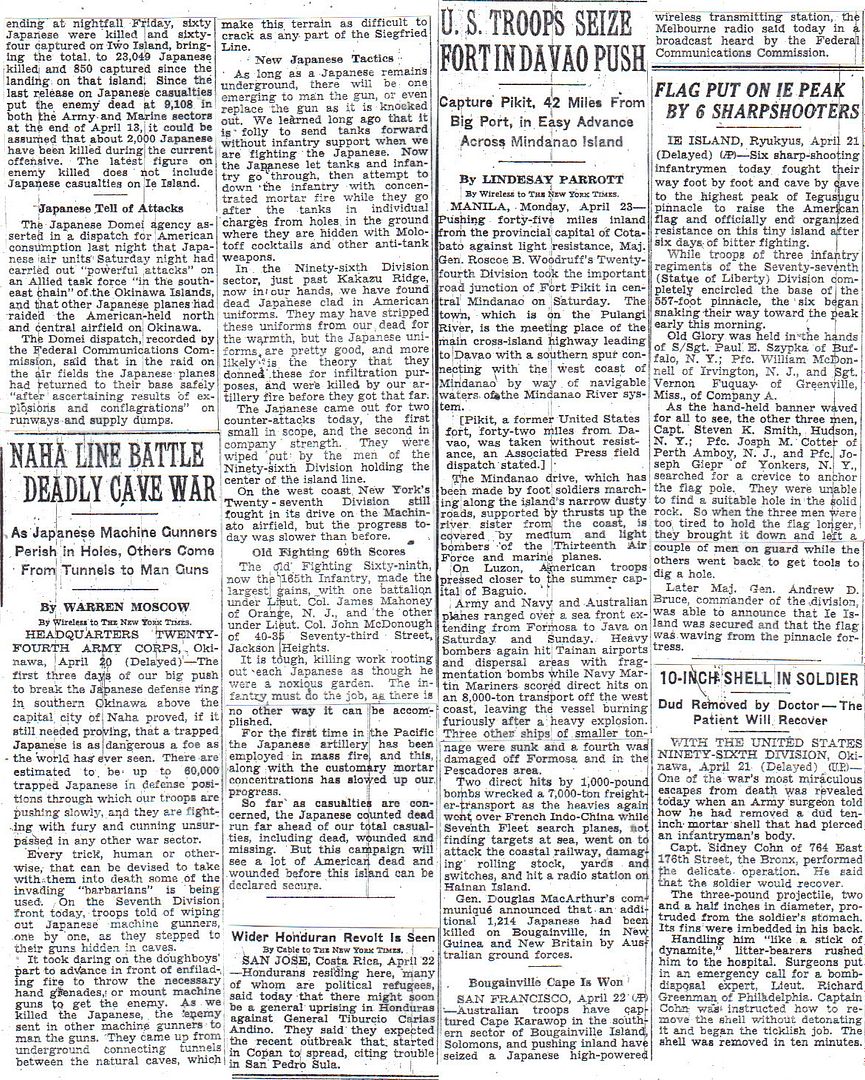
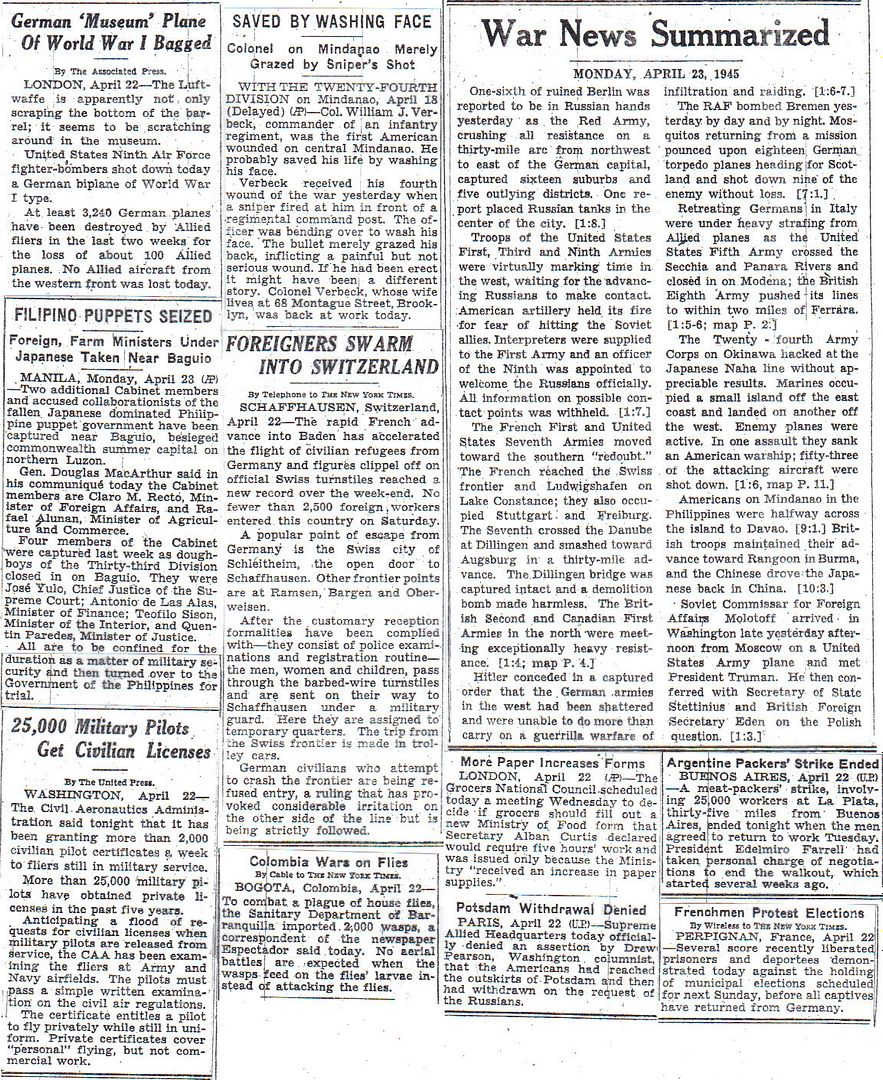
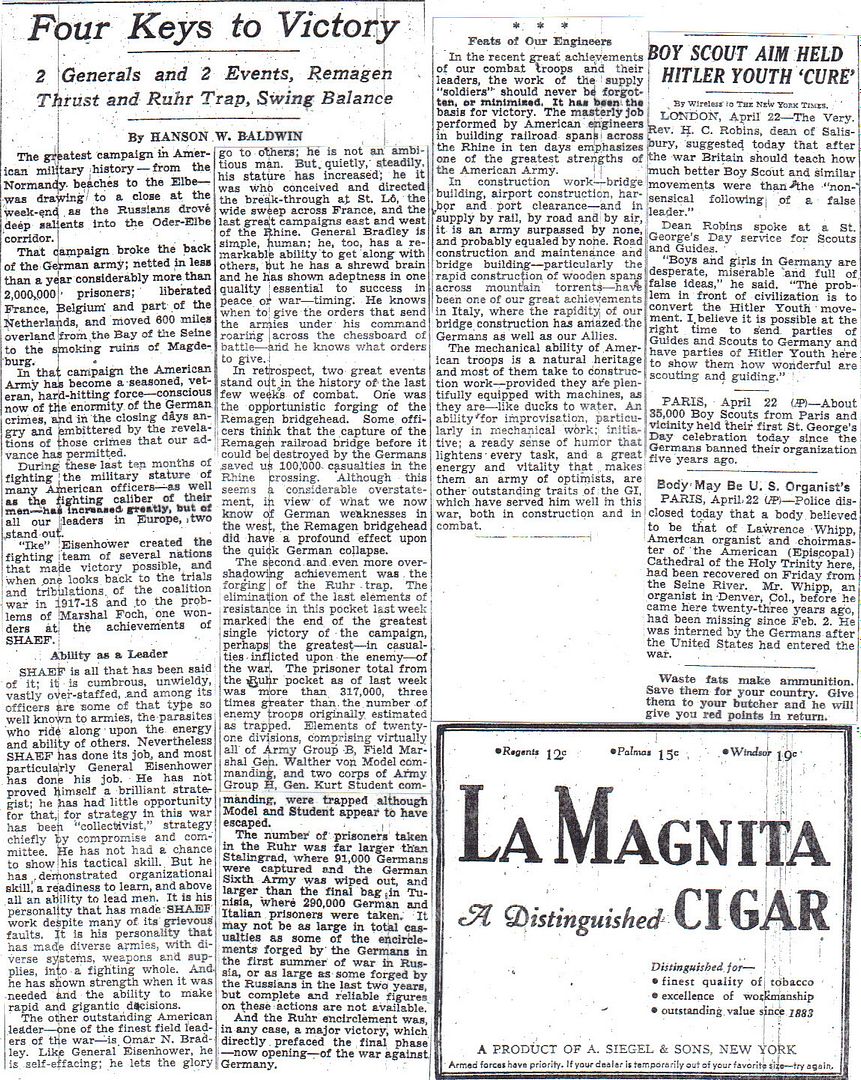
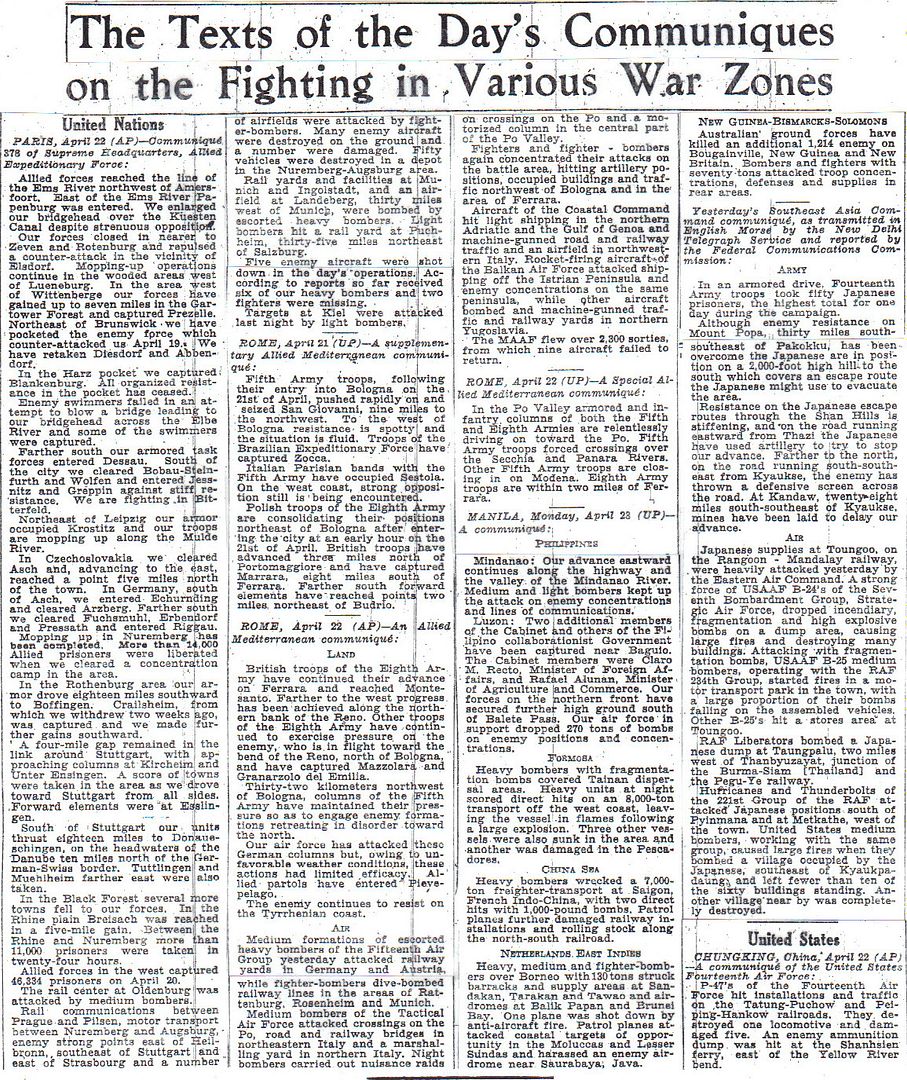

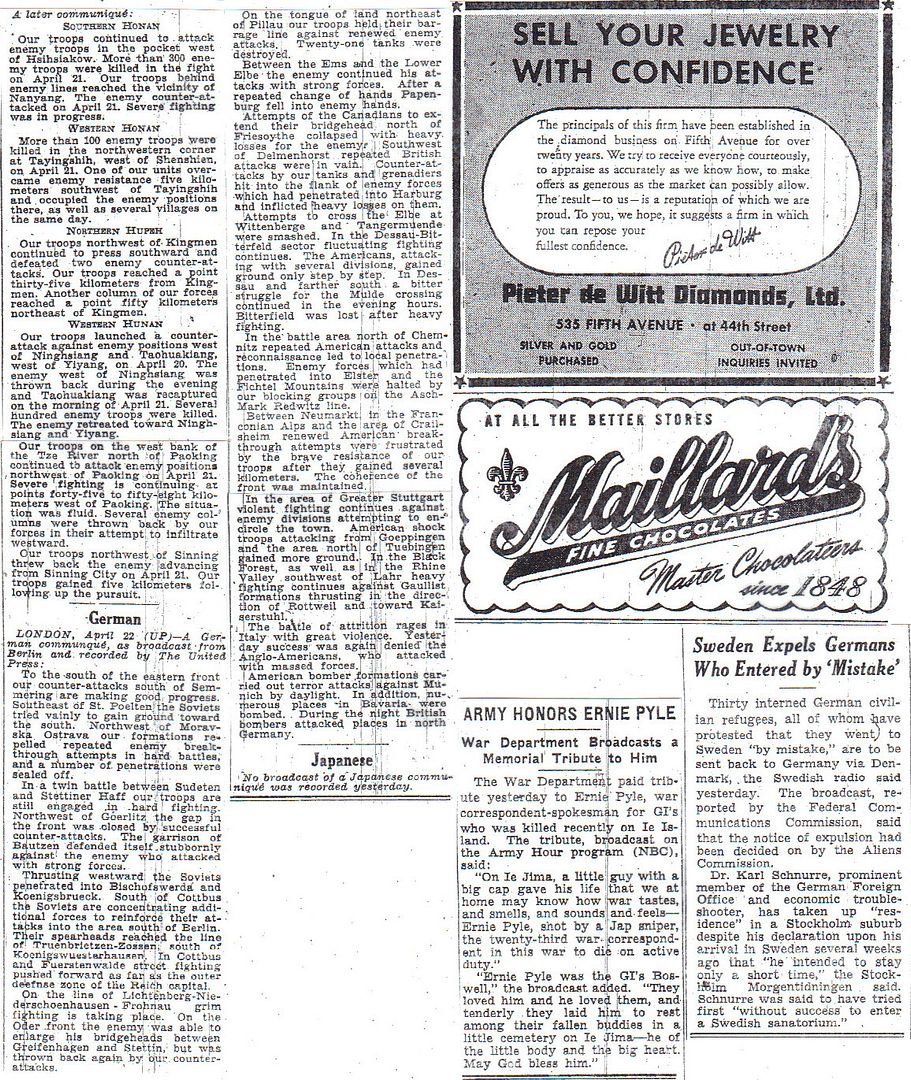
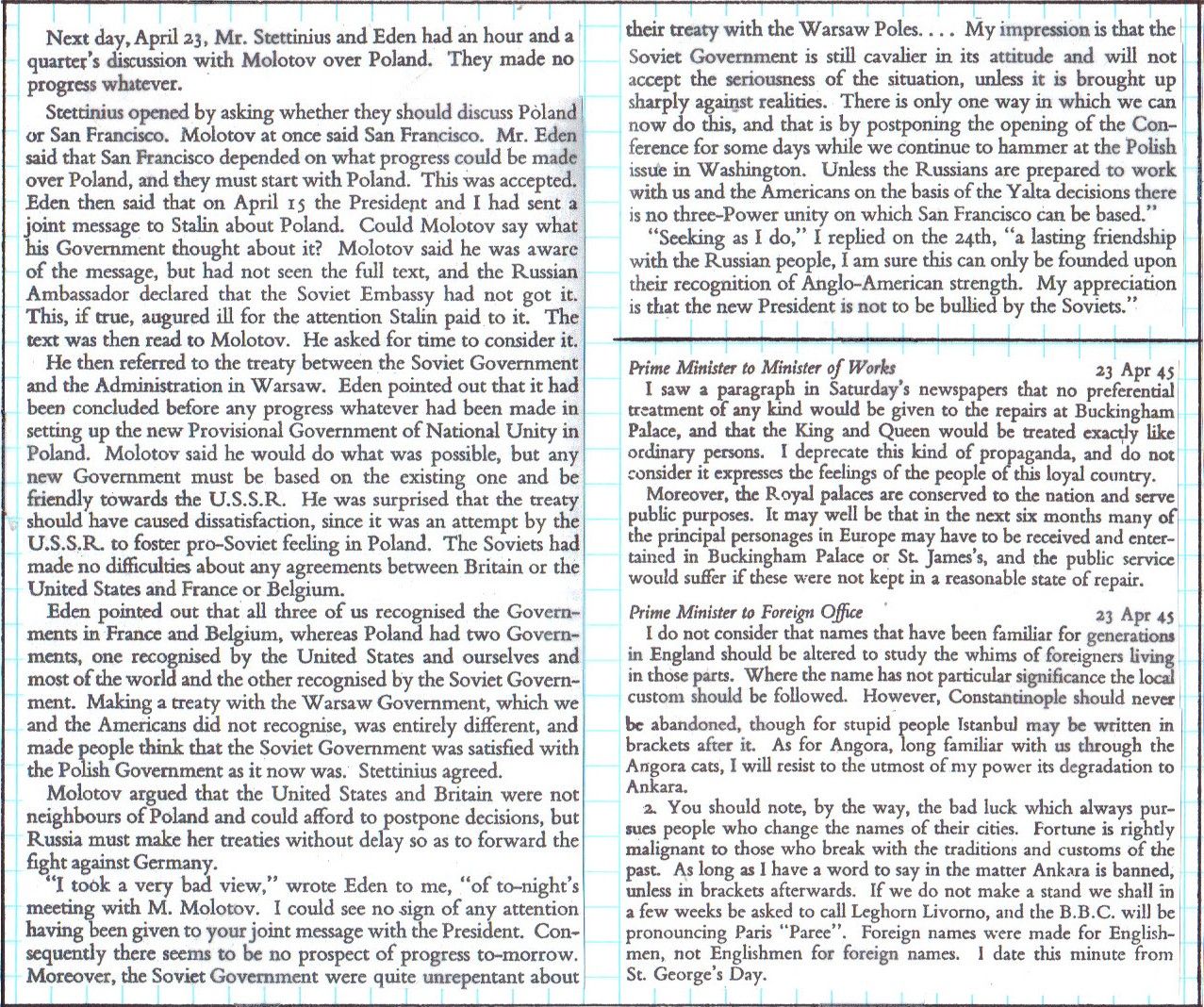
Winston S. Churchill, Triumph and Tragedy
http://www.etherit.co.uk/month/3/23.htm
April 23rd, 1945 (MONDAY)
UNITED KINGDOM:
Frigate HMCS Carlplace arrived Londonderry.
HMC ML 081 of 79th ML Flotilla completed refit.
Frigate HMCS Meon paid off and returned to RN at Southampton. Retained in post-war RN.
Submarine HMS Seneschal launched.
GERMANY: Hermann Göring sends a radio message to Hitler offering to take war leadership of the Reich if Hitler is unable to continue while the siege continues.
Berlin: Albert Speer bids Hitler farewell, confessing that he sabotaged the “scorched-earth” directive, and has preserved German factories and industry for the post-war period.
The Red Army has broken into Berlin from the north, east and south. Massed Russian artillery is shelling the central and western areas of the city. Buildings are collapsing piece by piece. Sturmovik aircraft dive over the rubble to silence German strongpoints. Latest reports say that Russian assault troops are smashing their way through the inner ring of SS resistance near the Stettiner railway station, one mile from the Unter den Linden.
Frankfürt am der Oder: After 6 days of heavy defensive fighting, the defenders of the city, assisted by 11.SS-Armee Korps [Kleinheisterkamp], gave very little ground to Soviet 1st Byelorussian Front. Massive and continuous artillery bombardments on the town from 20 to 22 April, 1945, reduced vast parts of the city to a wasteland of burning rubble. Still, the defensive perimeter remained intact. Zhukov’s 1st Byelorussian then sought to bypass and find a way around and behind the stubborn defenders. By 22 April the near breakup of 9th Armee into three isolated segments was dangerously close.
Hitler, at the insistence of Gen. Heinrici, allowed 9th Army to remove itself from continued [suicidal] holding of the Oder line-position, which allowed the extrication of the beleaguered and nearly surrounded garrison of ‘Festung-Frankfurt’ aided by elements of 11.SS-Armee.Korps, at the very last moment. The Russians [actually a Polish Tank Brigade of the Red Army] took possession of the city on 23 April 1945. Detonations and fire in the city centre area went on for a number of days beyond this, and have been attributed to both unexploded Allied aerial ordnance [The RAF raided Frankfurt a. Oder in late March and early April 1945], as well as to last ditch Hitler-Jugend attacks by the so-called ‘Werwolf’ organisation. (Russ Folsom)
Reichsjugendführer Artur Axmann gives a personal order that battalions of Hitler Youth be raised to defend the Pichelsdorf bridges across the River Havel in Berlin to keep the way open for Wenck’s phantom army.
Elements of the 2nd US Cavalry Group, 90th and 97th US Infantry Divisions liberate the 1,526 prisoners who remain in the Flossenbürg Concentration Camp near Weiden in NE Bavaria.
About 1,000 German civilians are massacred by the Red Army in the occupied town of Treuenbrietzen. Men are gathered together, taken to nearby woods and shot. A number of women are also raped and killed. Nearly every family in the town loses relatives.
Five kilometres up the road near the village of Nichel retreating German soldiers shoot 127 Italian forced labourers who had just escaped from a munitions factory in Treuenbritzen.
A brief history of KL Flossenbürg:
In May 1938,’Konzentrationslager’(KL)Flossenbürg in the district of Neustadt on the Waldnaab was established.(*) At first it was intended for “criminal and asocial elements”, but later the camp contained mostly political prisoners, in particular foreign nationals from the areas occupied by Germany during the war. The original camp was made up of 16 long, single level, wooden barracks, the kitchen, the laundry and disinfection buildings, the workshops, the camp prison (punishment block), crematorium, and roll call area. During the first years, prisoners were used primarily to build the camp and to labour in the granite quarry. After the war began, the prisoners were increasingly put to work in the armaments industry.
Eventually, the camp administered nearly a hundred satellite camps and external labour commands, some of which were quite a distance from the central camp at Flossenbürg, as far away as Bohemia and Saxony. Some 5,000 prisoners were held in the satellite camps, approximately one third of them were women.
“According to records found in the camp, from 1939 on, 54,890 men and over 10,000 women were held prisoner in KL Flossenburg. In the 14 month period preceding 20 April, 1945, 14,000 inmates died from starvation, exhaustion, mistreatment and various diseases. The prisoners worked in stone quarries and a nearby Messerschmitt Airplane Factory. On 20 April, 1945, 15,000 inmates, including children and elderly people, were marched away. Those that could not keep up the march were killed by the wayside. Less than 2000 were left in the camp when US troops arrived. Among those reported to have been in the camp were Kurt Von Schuschnig, former Chancellor of Austria; Leopold, King of Belgium, Prince Albrecht of Austria and Hjalmar Schacht, Reich Minister of Finances.”
A camp memorial was built between 1946 and 1948. The foundations, as well as a few complete prison barracks and the remains of the wall around the prison courtyard have been preserved. Two cells have been reconstructed in their original form on the west side of the prison barracks. Many well-known participants of the German [July 20th] resistance movement, including Pastor Dietrich Bonhoeffer, Admiral Wilhelm Canaris and Generalmajor Hans Oster were imprisoned and executed at the Flossenbürg Camp in April 1945.
(Source)
(*)Neustadt an der Waldnaab is in the Oberfalz region of NE Bavaria near the Czech border. (Russ Folsom)
ITALY: The US 5th and the British 8th Army reach the River Po. The 5th Army crosses south of Mantua.
BURMA: The First Division of the Indian National Army, fighting with the Japanese, surrenders en masse to the Allies.
JAPAN: The XXIV Corps attack begins to gain ground on Okinawa.
COMMONWEALTH OF THE PHILIPPINES: Units of the US 37th Division reach the outskirts of Baguio, Luzon.
JAVA SEA: U-183 sunk at 1300 in the Java Sea, in position 04.50S, 112.52E, by a torpedo from submarine USS Besugo. 54 dead and 1 survivor.
BORNEO: The US Navy’s Patrol Bombing Squadron One Hundred Nine (VPB-109) based at Puerto Princessa, Palawan, Philippine Islands, launches the Special Weapons Ordnance Device (SWOD) Mk. 9 for the first time against an enemy target. The SWOD Mk. 9, or “Bat” missile, is a glide bomb consisting of a 1,000 pound (453.6 kg) bomb casing equipped with wings, twin tail and internal radar to guide it. Two Bats are launched by a VPB-109 Consolidated PB4Y-2 Privateer against Japanese shipping in Balikpapan harbour in Borneo but both are defective and do not hit any targets.
U.S.A.: At 12:15pm U-853, five miles southeast of Cape Elizabeth, Maine, torpedoes and sinks USS Eagle (PE-56). The Eagle was at a dead stop. The explosion amidships sends a geyser of steam and water 200 feet skyward, breaking the ship in two and sinking her within minutes. 49 seamen are killed. (More on the Eagle boats.)
Destroyers USS Holder, Theodore E Chandler and Warrington laid down.
Destroyer USS Vesole commissioned.
ATLANTIC OCEAN: At 1535, U-1023 fired a spread of two LUT torpedoes at Convoy TBC-135 and heard one detonation and sinking noises. In fact, the Riverton was only damaged.
The unescorted Katy was torpedoed and damaged by U-857 east of Kitty Hawk. She was towed to Lynnhaven, Hampton Roads on 26 April and repaired. It is also possible that U-879 torpedoed this ship, but both U-boats were lost during April 1945 in that area and this success can not be definitely assigned to one of the boats.
U-396 reported missing from weather-reporting duties. No explanation exists for its loss. 45 dead (all hands lost).
U-1055 reported missing in the North Atlantic or the English Channel. No explanation exists for its loss. 49 dead (all hands lost).
Minesweeper HMCS Vegreville damaged by mines off French coast and headed for Devonport for repairs. The damage to her port engine was considered to be beyond economical repair and was declared a constructive total loss 6 Jun 45.
U-716 depth charged in the Arctic by a hunter-killer group. Due to the damage incurred the boat had to return to base.
http://www.history.com/this-day-in-history/truman-confronts-molotov
Truman confronts Molotov
April 23, 1945
Less than two weeks after taking over as president after the death of Franklin D. Roosevelt, Harry S. Truman gives a tongue-lashing to Soviet Foreign Minister Vyacheslav Molotov. The incident indicated that Truman was determined to take a “tougher” stance with the Soviets than his predecessor had.
When Roosevelt died of a massive stroke on April 12, 1945, Harry S. Truman took over as president. Truman was overwhelmed by the responsibilities so suddenly thrust upon him and, particularly in terms of foreign policy, the new president was uncertain about his approach. Roosevelt had kept his vice-president in the dark about most diplomatic decisions, not even informing Truman about the secret program to develop an atomic bomb. Truman had to learn quickly, however. The approaching end of World War II meant that momentous decisions about the postwar world needed to be made quickly. The primary issue Truman faced was how to deal with the Soviet Union. Just weeks before his death, Roosevelt met with Russian leader Joseph Stalin and British Prime Minister Winston Churchill at Yalta to discuss the postwar situation. Agreements made during the meeting left the Soviets in de facto control of Eastern Europe in exchange for Soviet promises to hold “democratic” elections in Poland. Some officials in the U.S. government were appalled at these decisions, believing that Roosevelt was too “soft” on the Soviets and naive in his belief that Stalin would cooperate with the West after the war. Truman gravitated to this same point of view, partially because of his desire to appear decisive, but also because of his long-standing animosity toward the Soviets.
On April 23, 1945, Soviet Foreign Minister Molotov arrived at the White House for a meeting with the new president. Truman immediately lashed out at Molotov, “in words of one syllable,” as the president later recalled. As Molotov listened incredulously, Truman charged that the Soviets were breaking their agreements and that Stalin needed to keep his word. At the end of Truman’s tirade, Molotov indignantly declared that he had never been talked to in such a manner. Truman, not to be outdone, replied that if Molotov had kept his promises, he would not need to be talked to like that. Molotov stormed out of the meeting. Truman was delighted with his own performance, telling one friend that he gave the Soviet official “the straight one-two to the jaw.” The president was convinced that a tough stance was the only way to deal with the communists, a policy that came to dominate America’s early Cold War policies toward the Soviets.
Personally, I would mark the Truman tongue-lashing of Molotov as the beginning of the Cold War.


Japanese Air Attack, USS Randolph (CV-15); Planes Shot Down, 4/23/1945
https://www.youtube.com/watch?v=xdr7Sb_hm8M
http://www.executedtoday.com/2008/04/23/1945-albrecht-haushofer-german-resistance-july-20-plot/
April 23, 1945
Execution of Albrecht Haushofer
On April 23, 1945, in Nazi Germany’s Berlin-Moabit prison, with the Red Army fast approaching, the SS executed Albrecht Haushofer for his part in the previous year’s July 20 plot to assassinate Adolf Hitler.
A social and political conservative and driving force behind the nascent field of “geopolitics,” which held views of the State “as a geographic organism or a spatial phenomenon” that were incorporated into the National Socialist ideology of “Lebensraum,” Haushofer was an early darling of the drive to find academic and scientific justification for Nazi beliefs and ideals — this despite his own part-Jewish parentage.
Haushofer had reservations about the intentions of the Nazi party following its rise to power in the 1930s, but he nonetheless consented to represent it in foreign affairs, having spent significant time abroad as a geopolitics student in the 1920s. Acting as chief foreign affairs adviser to Rudolf Hess, Hitler’s chief deputy, Haushofer traveled widely to promote German foreign policy. During this time, he wrote a series of historical dramas — Scipio (1934), Sulla (1938), and Augustus (1939) — containing progressively more strident symbolic criticisms of his age.
Believing that Germany must not get involved in another disastrous foreign war, Haushofer was a significant force in negotiating for peace with Britain and France. “The peoples of Europe are in a position in which they have to get on together lest they all perish,” he wrote; “and although one realises that it is not common sense but emotional urges which govern the world, one must try to control such urges.” As Hitler’s desire for war became ever more paramount, however, Haushofer lost his position with the government and returned to Germany, remaining active in secret talks to persuade the British to accept a new peace agreement.
With the outbreak of the Second World War, Haushofer remained a professor of geopolitics at the University of Berlin, but distanced himself from his Nazi past and began associating with elements of the German resistance. As the war wore on, he consistently opposed any attempt on Hitler’s life, but finally agreed to join the July plot as the only way to end the war without bringing further disaster upon Germany. With the plot’s failure, he was arrested by the Gestapo, and executed just days before the Red Army liberated Berlin.
Haushofer composed the Moabiter Sonette while in prison, a series of poems posthumously published in 1946 regarded as among the most powerful documents of the German antiwar movement. One of his most well-known sonnets, “Schuld,” attemps to express — in sad retrospect — the weight of his moral guilt in the face of impending death:
“Schuld”
…schuldig bin ich
Anders als Ihr denkt.
Ich musste früher meine Pflicht erkennen;
Ich musste schärfer Unheil Unheil nennen;
Mein Urteil habe ich zu lang gelenkt…
Ich habe gewarnt,
Aber nicht genug, und klar;
Und heute weiß ich, was ich schuldig war.
“Guilt”
I am guilty,
But not in the way you think.
I should have earlier recognized my duty;
I should have more sharply called evil evil;
I reined in my judgment too long.
I did warn,
But not enough, and clear;
And today I know what I was guilty of.
The poem’s last line can be variously translated as “And today I know what I was guilty of” or “And today I know what my obligation had been.” Through this subtle play on words, Haushofer created a powerful poetic link between his failure to act decisively and the supposed “guilt” — “not in the way you think” — for which he had been condemned. His poems remain a testament to the power as well as the responsiblities of the individual under dictatorship, and have earned their writer a place in the annals of history as well as modern-day memorials to the German resistance movement.
“Silence in the face of evil is itself evil: God will not hold us guiltless. Not to speak is to speak. Not to act is to act.”
- Dietrich Bonhoeffer
https://archive.org/details/ADC-4228b
U.S. Army [Radio] Contact With Russians, Walternienburg, Germany, 04/23/1945
Extracted from U.S. Army film Contact With Russians, Walternienburg (?), Germany ; Steel Gun Works, Bochumer-Vereim Steel Plant, Bochum, Germany, 04/23/1945” No National Archives description.
National Archives Identifier: 18030
http://www.doug-long.com/stimson2.htm
HIROSHIMA:
HENRY STIMSON’S DIARY AND PAPERS:
Part 2 (4/23/45 - 5/9/45)
The following are excerpts from Sec. of War Henry Stimson’s diary and papers that have relevance to the atomic bombing of Japan. This is by no means a complete collection of such references from Stimson’s diary and papers. These excerpts are published here with the authorization of the Yale University Library. The diary and papers can be found in the Henry Lewis Stimson Papers, Manuscripts and Archives, Yale University Library, New Haven, Conn. The diary and papers can also be found in the Library of Congress, Washington, DC and in the Center For Research Libraries, Chicago, IL.
For information about the prior Henry Stimson diary and papers, click Stimson Diary and Papers, Part 1.
[I have included some explanatory and contextual comments for the excerpts. My writing is in brackets and italics, as I have done with this paragraph.]
[HARRY TRUMAN LEARNS OF THE ATOMIC BOMB PROJECT]
[I’d like to start this section with some background from Harry Truman. In his Memoirs, President Truman wrote:]
“the first bit of information that had come to me about the atomic bomb” [was told to him by Henry Stimson (”Memoirs of Harry S. Truman”, Vol. 1, pg. 10). This would have occurred on the night of 4/12/45, after Truman was sworn in as president and after a short Cabinet meeting. Altho the Stimson diary does not mention it, Truman said Stimson] “asked to speak to me about a most urgent matter. Stimson told me that he wanted me to know about an immense project that was under way - a project looking to the development of a new explosive of almost unbelievable destructive power.” (”Memoirs”, Vol. 1, pg. 10).
[Truman went on to say:]
“The next day Jimmy Byrnes... came to see me, and even he told me few details, though with great solemnity he said that we were perfecting an explosive great enough to destroy the whole world.” (”Memoirs”, Vol. 1, pg. 11).
[For evidence that Truman may have known something about the atomic bomb project before 4/12/45, see David McCullough, “Truman”, pg. 289-290 and Robert Ferrell, “Harry S. Truman: A Life”, pg. 172 & 418 (note 37).].
[Truman later wrote of his reaction to Stimson’s 4/25/45 discussion of the atomic bomb:]
“Stimson... seemed at least as much concerned with the role of the atomic bomb in the shaping of history as in its capacity to shorten this war.” (Truman, “Memoirs”, Vol. 1, pg. 87).
[Stimson’s 4/23/45 diary entry spoke of a meeting that day with Truman that illustrates how future foreign relations occupied much of Stimson’s thinking at this time.]
4/23/45 Diary Entry:
“...I was plunged into one of the most difficult situations I have ever had since I have been here.
“[Sec. of State Edward] Stettinius had gotten into a jam with Molotov, the Foreign Minister of Russia, who arrived yesterday. The subject is Poland. The Russians had apparently flatly refused to permit the agreement at Yalta [the Feb. 1945 conference between Great Britain, Russia, and the U.S.] to be carried out to select a mixed delegation from Poland and they are insisting that the Lublin [Russian dominated] people shall be recognized as the government of Poland. ...we are at loggerheads with Russia on an issue which in my opinion is very dangerous and one which she is not likely to yield on in substance. Furthermore, although at Yalta she apparently agreed to a free and independent ballot for the ultimate choice of representatives of Poland, yet I know very well from my experience with other nations that there are no nations in the world except the U.S. & the U.K. which have a real idea of what an independent free ballot is. I learned that in Nicaragua and in South America, and I was very much alarmed for fear that we were rushing into a situation where we would find ourselves breaking our relations with Russia on the most important and difficult question which we and Russia have got between us.
“...I...told the President that I was very much troubled by it and I pointed out all these difficulties that I have just spoken of. I said that in my opinion we ought to be very careful and see whether we couldn’t get ironed out on the situation without getting into a headon collision. He was evidently disappointed at my caution and advice...”. “And nobody backed me up until it came round to Marshall who wasn’t called until towards the end. Then to my relief a brave man and a wise man spoke; and he said that he, like me, was troubled and urged caution.
“You can see that the State Department has got itself into a mess. Contrary to what I thought was the wise course, they have not settled the problems that lie between the United States and Russia and Great Britain and France, the main powers, by wise negotiations before this public meeting [the United Nations first meeting, 4/25/45] in San Francisco, but they have gone ahead and called this great public meeting of all the United Nations, and they have got public opinion all churned up over it and now they feel compelled to bull the thing through.” “...it was a very embarrassing meeting and finally the President said goodbye to [Sec. of the Navy James] Forrestal and myself and Marshall and [Chief of Naval Operations, Admiral Ernest] King and said he was going to go on and talk the thing over and try to make up his mind with the others. I have very grave anxiety as a result since then as to what will happen.”
“...I had a conference with General [Leslie] Groves [head of the Manhattan Project] and George Harrison [an assistant to Stimson] in regard to my coming meeting with the President over S-1. They have drawn up a very interesting summary of the whole situation and I read that and talked with them about it.”
4/24/45 Diary Entry:
“I wrote a letter to the President suggesting a talk on S-1 and during the rest of the day I read over again carefully General Groves’ analysis and report on S-1, and late in the afternoon with Harvey Bundy [an assistant to Stimson] I wrote a memorandum giving an analytical picture of what the prospects of S-1 are and the problems which it presents to this country.”
[Stimson’s letter to President Truman, which Truman received on 4/24/45]:
“Dear Mr. President,
I think it is very important that I should have a talk with you as soon as possible on a highly secret matter. I mentioned it to you shortly after you took office but have not urged it since on account of the pressure you have been under. It, however, has such a bearing on our present foreign relations and has such an important effect upon all my thinking in this field that I think you ought to know about it without much further delay.” (Truman, “Memoirs”, Vol. 1, pg. 85).
4/25/45 Diary Entry:
“I spent the first part of the morning going over with Harrison and Bundy the brief memorandum on S-1 which I had drafted with Bunder yesterday. I also showed it to [Army Chief of Staff General George] Marshall and to Groves who came in. Finally when we got it approved by all, I set it aside and called it a job.”
[To see the above mentioned memorandum that Stimson gave to President Truman that day, click Stimson’s 4/25/45 memorandum.]
“At twelve o’clock noon I went over for my conference with the President at the White House over S-1. General Groves was to meet me there, but he had to take a secret road around because if the newspaper men, who are now gathered in great numbers every morning in the President’s anteroom, should see us both together there they would be sure to guess what I was going to see the President about. So Colonel [Frank] McCarthy, the Secretary of the General Staff, arranged to have General Groves conducted around through underground passages to a room near the President and there wait till I had got far on in my talk with the President. The talk worked very well indeed. First of all I showed the President the paper that I had drawn yesterday and this morning. It is on the political aspects of the S-1 performance and the problems which are involved with the public. He read it carefully and was very much interested in it. I then produced General Groves and his account of the manufacturing operation, and Groves and I and this report explained the matter to the President. The President took one copy and we took the other and we went over it and answered his questions and told him all about the process and about the problems that are coming up and in fact I think very much interested him. He was very nice about it. He remembered the time that I refused to let him to into this project when he was chairman of the Truman Committee [a Senate committee which investigated military spending] and was investigating it, and he said that he understood now perfectly why it was inadvisable for me to have taken any other course than I had taken.”
“After three-quarters of an hour with the President, I left the White House...”
“...I had a talk with Bundy and Harrison over my interview this morning and they both seemed to think a great deal had been accomplished. I think so too.”
5/1/45 Diary Entry: [Interim Committee proposal Oked by Truman]
“At ten o’clock Harvey Bundy and George Harrison brought in to me a paper which Harrison had drawn in reference to S-1 and in reference to the appointment of a commettee to outline a program of action now that we are getting close to the time when something is likely to happen which will require publicity. Harrison had drawn a very good paper. I approved it and I also approved the committee which he proposed that I should propose to the President to cover that.” [Vannevar Bush and James Conant had been urging Stimson and his staff to create a committee to study the problems that could result from the creation of the atomic bomb].
“I took Harrison’s paper to Marshall because I wanted to have him approve it, he being one of the very few men that know about S-1, and he did approve it.”
[Harrison’s 5/1/45 paper suggested “setting up a committee of particular qualifications for recommending action to the executive and legislative branches of the government when secrecy is no longer fully required.” The paper emphasized, “Most importantly as soon as possible after use [of the atomic bomb] some assurance must be given of the steps to be taken to provide the essential controls over post war use and development, both at home and abroad.” Regarding the atomic bomb, Harrison added, “If misused it may lead to the complete destruction of civilization.” He summarized his recommendation with, “I suggest that a committee of six or seven be set up at once to study and report on the whole problem of temporary war controls and publicity, and to survey and make recommendation on post war research, development and controls, and the legislation necessary to effectuate them (Manhattan Engineering District Records, Harrison-Bundy files, folder # 69, RG 77, National Archives).]
5/2/45 Diary Entry:
“...my meeting with the President at 11:30 which was on the subject of S-1. I was delayed for about half an hour from getting in to the President by his earlier callers but when I got in we had a very pleasant and satisfactory conference. He told me not to hurry but to take my time as the delay had been his fault. So I had quite a satisfactory talk with him. The following are notes made by me after this meeting with the President:
1. S-1. The President accepted the present members of the Committee and said that they would be suffient even without a personal representative of himself. I said I should prefer to have such a representative and suggested that he should be a man (a) with whom the President had close personal relations, and (b) who was able to keep his mouth shut. The President took our list and said that he would try to think up such a man as I suggested. [Stimson then went on to list non-Pacific War issues].
5/3/45 Diary Entry:
“I had several conferences during the day with George Harrison and Bundy over S-1 and I called up the President to suggest that Jimmy Byrnes would be a good man to put in the position [as the President’s representative] on the committee for S-1 that I had told the President about when I saw him yesterday, and late in the afternoon the President called me up himself and said that he had heard of my suggestion and it was fine. He had already called Byrnes up down in South Carolina by telephone and Byrnes had accepted. So my [Interim] committee is now complete. Bundy and Harrison were tickled to death with this Byrnes suggestion and now we can start at work on preparing for the many things that must be planned for S-1.”
“At one o’clock I had [Supreme Court] Justice [Felix] Frankfurter as my guest. He had asked for the appointment and said it was very important and, when he finally revealed it, by Jingo it was a talk about S-1 which he had learned of from a Danish scientist whom he came in contact with in London and who is here in America now. [Niels Bohr. According to Frankfurter, he learned of the atomic bomb project from “some distinguished American scientists” rather than from Bohr (Richard Rhodes, “The Making of the Atomic Bomb”, pg. 526)]. I found that Frankfurter had talked over the question of S-1 with the President [Roosevelt] and knew quite a good deal about it. He was worried on exactly the same subject that I have been at work on for the past two or three days and on which I have finally appointed this [Interim] Committee. He was much relieved to find how well we had the affair in hand.”
5/4/45 Diary Entry:
“In re S-1. After Cabinet [meeting] I asked the President for the details for the J. F. Byrnes acceptance of membership on my [Interim] committee and he said he accepted; that he was coming here tomorrow, May 5th, would be here over Sunday, Monday, Tuesday, and Wednesday [i.e., thru May 9th]. I told the President that we were at work on the agenda so as to get the thing started as soon as Byrnes was available.”
[The invitations to become members of the Interim Committee were sent by Stimson on 5/4/45. Those invited were James Byrnes (as President Truman’s representative; he would soon become Sec. of State), Vannevar Bush (Director, Office of Scientific Research and Development), Karl Compton (Chief, Office of Field Service, Office of Scientific Research and Development ), James Conant (Chairman, National Defense Research Committee), William Clayton (Assistant Sec. of State), and Ralph Bard (Under Sec. of the Navy). Stimson was chairman of the committee, and George Harrison was his alternate. All who were invited to become members accepted. As to the Interim Committee’s function, the invitations read:]
“With the approval of the President, I am appointing an Interim Committee on S-1 to study and report on the whole problem of temporary war controls and later publicity, and to survey and make recommendations on post war research, development and controls, as well as legislation necessary to effectuate them.” (Bush-Conant Files, Folder 19, RG 227, National Archives).
5/8/45 Diary Entry:
“At about half past three Justice Byrnes came in and for two hours I talked with him first alone and then bringing in General Groves, Bundy, and Harrison. I first unfolded to him the story of S-1 [of which Byrnes already had knowledge] and then we all discussed the functions of the proposed Interim Committee. During the meeting it became very evident what a tremendous help Byrnes would be as a member of the Committee.”
[Byrnes’ influence over the Interim Committee has often been noted by those who have studied the Committee. The explanation usually given for Byrnes’ influence has been that he was the President’s representative. Another possible reason, altho I have found no corroboration for it, can be found in Sec. of the Navy James Forrestal’s diary entry for 5/8/45: “...Stimson told [Acting Sec. of State Joseph] Grew and myself that he was forming a committee on manhattan to be headed by Jimmy Byrnes...” [my underlining] (Walter Millis, ed. “The Forrestal Diaries”, pg. 54). Stimson was chairman of the Interim Committee.]
5/9/45 Diary Entry: [The first Interim Committee meeting]
“At ten minutes to ten my first conference of the Interim Committee which I am appointing in S-1 got under way. Everybody was present except Dr. Conant, viz: Byrnes, Bush, Compton, Bard, Clayton, Groves, Bundy, and Harrison and myself. Several of the members did not know the basic facts in the matter and I explained them to them, and we had a talk over the whole subject until nearly eleven when Harrison and Groves took them off into another room to go further into details.”
[In the Interim Committee notes for the 5/9/45 meeting, the topics Stimson told the Committee they should address are almost identical to those listed in his invitations to join the Committee. The 5/9/45 meeting notes state:]
“Secretary Stimson... expressed his views as to the purposes and functions of the Committee. Appointed by the Secretary with the approval of the President, the Committee was established to study and report on the entire problem of temporary war-time controls and later publicity, and to survey and make recommendations on post-war research, development, and control, and on legistation necessary for these purposes.” (Manhattan Engineering District Records, Harrison-Bundy files, folder # 100, RG 77, National Archives).
[No mention was made in the meeting notes of any role for the Committee in recommending whether or not the atomic bomb should be used, nor was the Committee given essential military and diplomatic information that would have enabled it to make an informed recommendation on whether the atomic bomb should be used.]
Po Valley
5 April-8 May 1945
*excerpt*
In the west, the 10th Mountain Division's spearhead reached the Po River at San Benedetto, thirty miles north of Ponte Samoggia, on the evening of 22 April. By midnight, the rest of the division had arrived' and river-crossing equipment followed. Masses of destroyed enemy materiel littered the south bank of the Po, showing the devastating effects of Allied air power. Not one bridge remained standing. As the 10th Mountain Division waited to cross, the 1st Armored Division skirted Modena over a captured Panaro River bridge four miles north of Highway 9, then moved west, reaching a southwestern loop of the Po on 23 April. The units' armored vehicles then spread out along several miles of the river's southern bank to block crossings by any remaining enemy soldiers bypassed in the headlong race for the river. The rapid American advance along the forty-mile-wide front had left many pockets of Axis soldiers, and special task forces were now created to mop up rear areas as the main Allied units pressed farther northward. Ultimately, over 100,000 Axis troops were forced to surrender in the areas south of the river.
Although the majority of the Po River bridges were destroyed, the U.S. 85th Infantry Division, like other fast-moving Fifth Army units, had been able to take many spans south of the Po intact, such as the Panaro River bridge at Camposanto, eleven miles north of Ponte Samoggia. Early on 22 April, fearing efforts of enemy rear-guard units to destroy the span, a sergeant from the division's 310th Engineer Battalion quickly plunged into the river, cut the demolition wires under enemy fire, and saved the structure from destruction. Once across, the 310th repelled an enemy attempt to retake the bridge and to hold the town. As one regiment cleared Camposanto and secured the span, another swung to the left, crossed the bridge seven miles south at Bomporto, and quickly covered the intervening twenty-four miles of territory, arriving at the Po River just before noon on 23 April 1945. The division then cleared the south bank, capturing hundreds of prisoners and much equipment in the process. Later in the day a westward shift of corps boundaries caused the 85th Division to relinquish some of its territory to the 88th Division, which had only left the Panaro River early that morning. The 85th then prepared to cross the Po River in force the next day.
By 24 April the entire Fifth Army front had reached the Po. In the west, IV Corps units advanced west, northwest, and north, pushing forward bridging equipment for an offensive across the river. In the 10th Division area, fifty M-2 assault boats enabled the unit to begin ferrying troops across at noon. Air bursts from German artillery caused some casualties, but enemy actions failed to significantly delay the crossings here or elsewhere. Once on the far bank, the 10th Mountain quickly secured its bridgehead. By 1800 hours two regiments were on the far bank, with the division's third regiment crossing during the night.
*excerpt*

Prisoners were captured by the tens of thousands in the Po Valley and marched to the rear, often unguarded or guarded by only one or two men. (National Archives)

Unknown to the allies, Hitler has already done himself in, no?
Not quite yet, although he has made the decision to die in the Bunker.
42 Div 232 Inf April 23-25 cont’d
At 1030, 23 April, the regiment again continued the attack to the south in a column of Battalions, with the First Battalion leading, followed by the Second and Third in order. Resistance was increasing as the regiment near the Danube river, and the First Battalion had many fights during the day of April 23. The heaviest battle of the day was in the vicinity of Dockingen where the First Battalion battled its way through heavy artillery, casualty rate was high. The fighting ended after dark, and found the First Battalion located on the high ground south of Dockingen, The Third Battalion located in the town of Dockingen, and the Second Battalion and the Regimental CP in Degersheim the night of 23-24 April.
Early on the morning of 24 April the regiment began its approach to the Danube. The attack was resumed with the Second Battalion and Third Battalion passing through the First Battalion and attacking abreast, Second Battalion on the right.The attack progressed steadily throughout the day, meeting only local action from small delaying forces. All Battalions reached their objectives by dark with the Second Battalion closing into Itzing, where the advance regimental elements established the CP, the Third Battalion into Ried, and the First which had followed the Third Battalion into Kruit.
I look back, now so long ago, to this period and I’m glad I was 19. It was move, move, move anyway, riding trucks, tanks, whatever, no sleep, K-rations, bypassing any minor resistance. The ‘beautiful blue Danube’ is coming up. If it is like all the other rivers, it won’t be beautiful or blue. Reminds me of an article I read about a bridge in Pennsylvania some years back. The time estimate to complete the bridge was some 2 years. A WW II Engineer wrote in that he could not understand this time. “We build a bridge to support tanks overnight while being shot at.” Indeed the engineers were good, very good.
Disclaimer: Opinions posted on Free Republic are those of the individual posters and do not necessarily represent the opinion of Free Republic or its management. All materials posted herein are protected by copyright law and the exemption for fair use of copyrighted works.